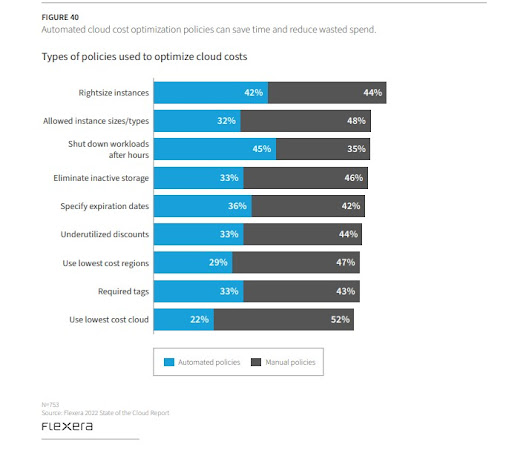
What Are Organisations Doing To Optimise Cloud Costs?
The covid-19 pandemic played a vital role in the increase in cloud technology adoption for many organisations globally. According to the Mordor Intelligence report 87% of businesses in the U.S. accelerated their cloud migrations after the COVID-19 pandemic and the cloud migration market is forecasted to grow from $120 billion to $450 billion in 2026 due to the increased demand of cloud computing services.
As companies are moving their digital assets, services, databases, IT resources, and applications to the cloud, one question remains persistent; how do we manage our cloud cost? How do we make sure we’re leveraging the pay-as-you-go or ‘pay only for what you need’ pricing structure, and not spending more than we should be spending?.
This post will answer that question by highlighting some of the policies organisations are implementing, globally, to better optimise their cloud costs.

What Is Cloud Cost Optimisation?
Cloud cost optimization is the process of reducing your overall cloud spend by identifying mismanaged resources, eliminating waste, reserving capacity for higher discounts, and right sizing computing services to scale. Cloud cost optimization enables you to find ways to run applications in the cloud, performing work or providing value to your business, at the least possible cost, and using your cloud environment as cost-efficiently as possible. For example, a new business starting off might build applications in the cloud with the pay-as-you-go cost model in mind, but changes, human vunerabilities and lack of cost awareness will create opportunities for cost optimization. Cloud cost optimization therefore aims at reducing costs while performance is optimised.
What Are Companies Doing To Optimise Their Cloud Cost?
As aforementioned about the rise of cloud adoption by organisations, cloud cost optimization is a critical issue. With the many benefits cloud computing offers, costs associated with these benefits can be difficult to track and manage. This is why organisations are relying on cloud cost optimization policies to understand and control their cloud costs.
These are some of the policies organisations are implementing to optimise their cloud costs:
- Right-sizing cloud resources: Companies optimize their cloud costs by ensuring that their cloud resources are sized correctly to their workloads. This means that they are not incurring unnecessary costs for resources that are not being utilised to their fullest potential.
- Automating cloud management: Companies use automation to optimize their cloud costs. Automation can help streamline processes, such as automatically scaling cloud resources up and down according to demand, and scheduling tasks like backups.
- Scheduling non-production resources: Non-production resources amount to over 70% of cloud wastes. Companies are ensuring that non production resources are shut down during off work hours.
- Utilizing Reserved Instances: Companies optimise their cloud costs by taking advantage of reserved instances. These are long-term commitments to a specific type of cloud resource, such as an Amazon EC2 instance.
- Leveraging Spot Instances: Companies optimise their cloud costs by using spot instances. Spot instances enable companies to bid on unused cloud resources, allowing them to pay a much lower rate than usual.
- Optimizing storage: Companies optimize their cloud costs by optimizing their storage. This can include using object storage instead of block storage, and taking advantage of storage-optimized instances.
Flexera shows that these policies are being implemented either manually or automatically, and the figure below shows that more organisations are leaning towards the automatic implementation of these policies, leveraging cloud Cost optimisation SaaS tools to ensure an automated flow of these cost optimisation policies.

Wendu and Automated Cloud Cost Optimisation Policies
- Rightsizing Instances: One of the main insights you need to have in order to rightsize your instances is its usage analysis. Wendu gives you usage analysis on your instances and AWS resources, which helps you rightsize your instance, and follow cost optimization best practices.
- Allowed Instance size/type: Selecting the right instance size and type based on your cloud usage is also another insight Wendu gives you. EC2 size / type recommendations based on your current usage can save you up to 75% when implemented.
- Scheduling non-production resources: Wendu, with its EC2 and RDS Schedulers, helps you automate shutting down these resources after work hours, and switching them back up for when needed, and this saves up to 60% of your cloud costs.
Learn more about Wendu here, and you can also request a demo to see Wendu in action.